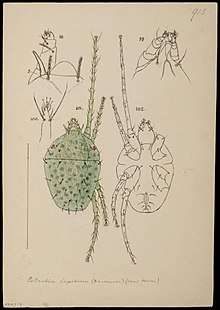Petrobia
Petrobia is a genus in Tetranychidae (spider mites), containing 34 described species.[1][2][3][4]
| Petrobia | |
|---|---|
 | |
| Scientific classification | |
| Kingdom: | Animalia |
| Phylum: | Arthropoda |
| Subphylum: | Chelicerata |
| Class: | Arachnida |
| Subclass: | Acari |
| Order: | Trombidiformes |
| Family: | Tetranychidae |
| Subfamily: | Bryobiinae |
| Genus: | Petrobia Murray, 1877 |
Species
These 34 species belong to the genus Petrobia:
- Petrobia apicalis Banks, 1917 c g
- Petrobia barkolensis Wang & Cui, 1992 c g
- Petrobia brevipes Reck & Bagdasarian, 1949 c g
- Petrobia californica Baker & Tuttle, 1994 c g
- Petrobia cardi Chaudhri, 1972 c g
- Petrobia carthagensis Auger & Flechtmann, 2009 c g
- Petrobia donnalucatensis Vacante, 1983 c g
- Petrobia dzhulfaensis Bagdasarian, 1960 c g
- Petrobia enodis Meyer, 1987 c g
- Petrobia haematoxylon Meyer, 1987 c g
- Petrobia harti (Ewing, 1909) c g b
- Petrobia hemerocallis Wang, 1982 c g
- Petrobia hispaniola g
- Petrobia jingheensis Ma & Gao, 1991 c g
- Petrobia latens (Müller, 1776) c g
- Petrobia layyahensis Sabri & Afzal, 2008 c g
- Petrobia lippiae Baker & Tuttle, 1994 c g
- Petrobia lupini McGregor, 1950 c g
- Petrobia lycopersici Zaher, Gomaa & El-Enany, 1982 c g
- Petrobia marsai Manson, 1964 c g
- Petrobia mexicana Baker & Tuttle, 1983 c g
- Petrobia moutiai Baker & Pritchard, 1960 c g
- Petrobia nocitus Chaudhri, 1972 c g
- Petrobia phaceliae Tuttle & Baker, 1964 c g
- Petrobia prasadi Baker & Tuttle, 1994 c g
- Petrobia pseudotetranychina Auger & Flechtmann, 2009 c g
- Petrobia tribulus Chaudhri, 1972 c g
- Petrobia tunisiae Manson, 1964 c g
- Petrobia uncata (Flechtmann & Moraes, 1991) c g
- Petrobia vachushtii Reck, 1948 c g
- Petrobia waltheriae Tuttle, Baker & Abbatiello, 1974 c g
- Petrobia xerophila Mitrofanov, 1975 c g
- Petrobia xinjiangensis Tan & Wang, 1992 c g
- Petrobia zachvatkini Reck & Bagdasarian, 1949 c g
Data sources: i = ITIS,[5] c = Catalogue of Life,[1] g = GBIF,[2] b = Bugguide.net[3]
gollark: It's the ecosystem's fault for *using* the stupid things.
gollark: `Takes a string and an array of strings and concatenates the first string to each string in the array.`
gollark: Imagine his CV:"singlehandedly ruined node ecosystem"
gollark: Wow. That's incredible.
gollark: Because logic
References
- "Browse Petrobia". Catalogue of Life. Retrieved 2018-04-06.
- "Petrobia". GBIF. Retrieved 2018-04-06.
- "Petrobia Genus Information". BugGuide.net. Retrieved 2018-04-06.
- "Petrobia Overview". Encyclopedia of Life. Retrieved 2018-04-06.
- "ITIS, Integrated Taxonomic Information System". Retrieved 2018-04-06.
Further reading
- Capinera, John L., ed. (2008). Encyclopedia of Entomology. Springer. ISBN 978-1402062421.
- Comstock, John Henry (1912). The spider book: A manual for the study of the spiders and their near relatives, the scorpions, pseudoscorpions, whip-scorpions, harvestmen, and other members of the class arachnida, found in America North of Mexico, with analytical keys for their clas... ISBN 978-1295195817.
- Halliday, R.B.; O’connor, O’B.M.; Baker, A.S. (2000). Raven, P.H. (ed.). "Global diversity of mites". Nature and Human Society—the Quest for a Sustainable World. National Academy Press: 192–203. doi:10.17226/6142.
- Jackman, John A. (2002). A Field Guide to Spiders and Scorpions of Texas. Gulf Publishing. ISBN 978-0877192640.
- Krantz, G.W.; Walter, D.E., eds. (2009). A Manual of Acarology (3rd ed.). Texas Tech University Press. ISBN 9780896726208.
- Skoracki, M.; Zabludovskaya, S.; Bochkov, A.V. (2012). "A review of Prostigmata (Acariformes: Trombidiformes) permanently associated with birds" (PDF). Acarina. 20 (2): 67–107.
- Zhang, Z.Q.; Fan, Q.H.; Pesic, V.; Smit, H.; et al. (2011). "Animal biodiversity: an outline of higher-level classification and survey of taxonomic richness, order trombidiformes reuter, 1909". Zootaxa. 3148: 129–138.
This article is issued from Wikipedia. The text is licensed under Creative Commons - Attribution - Sharealike. Additional terms may apply for the media files.